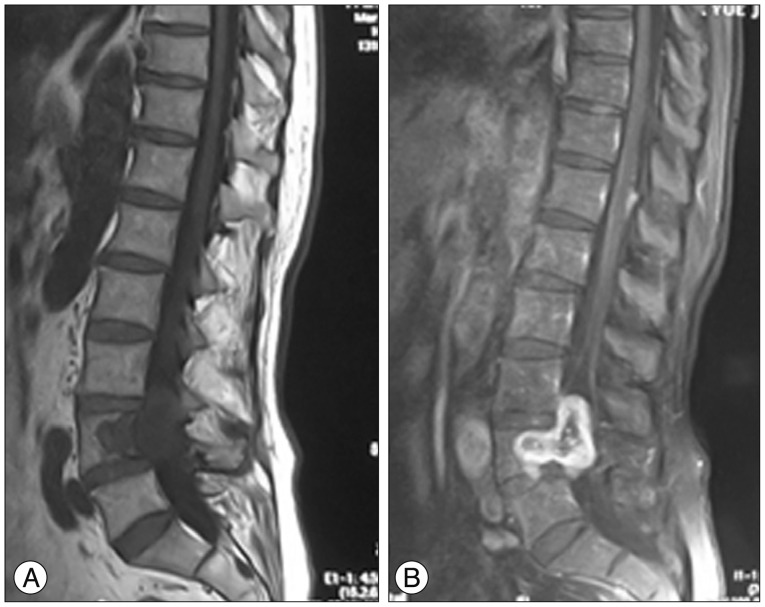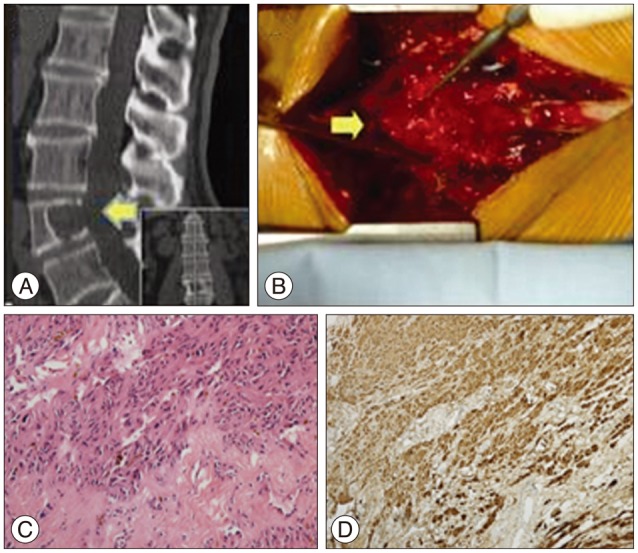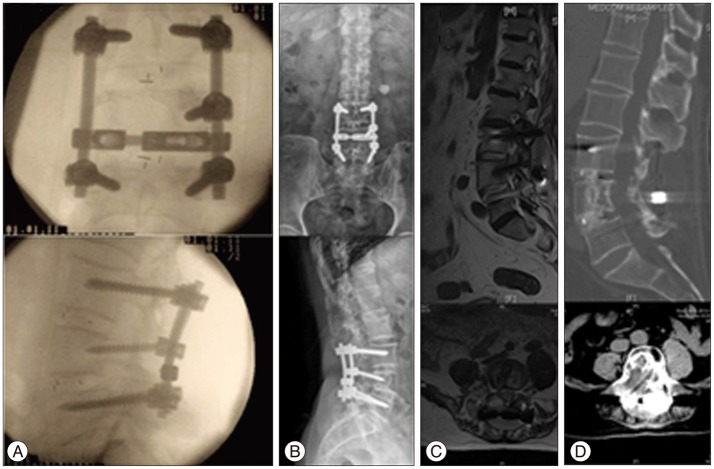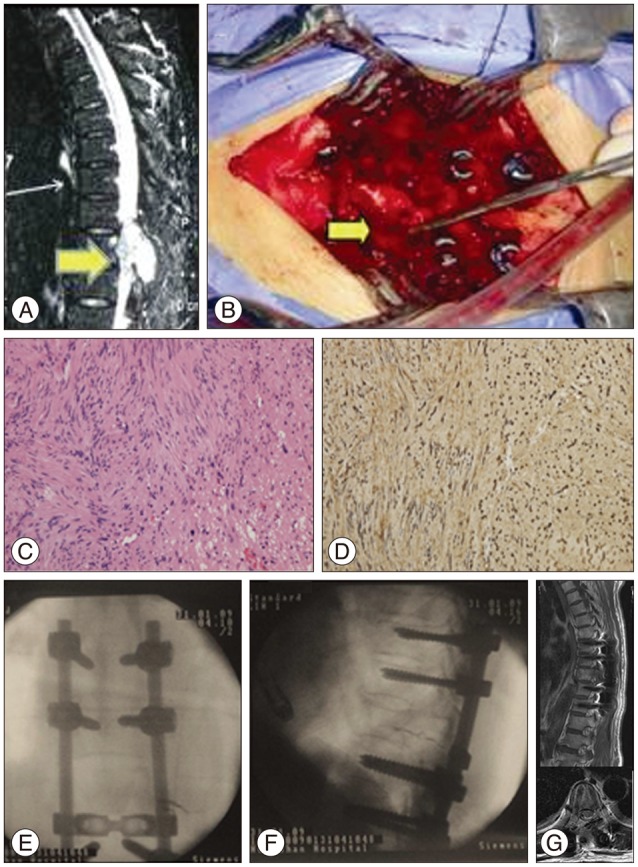J Korean Neurosurg Soc.
2015 Jun;57(6):478-483. 10.3340/jkns.2015.57.6.478.
Two Case Reports and an Updated Review of Spinal Intraosseous Schwannoma
- Affiliations
-
- 1Department of Orthopedics, Huashan Hospital, Fudan University, Shanghai, China. lufeizhou2012@126.com
- KMID: 2191259
- DOI: http://doi.org/10.3340/jkns.2015.57.6.478
Abstract
- We report two rare cases of spinal intraosseous schwannoma (SIS) with sustained myelopathy symptoms and provide an updated review regarding SIS in the literature. A 71-year-old man experienced right lumbocrural pain and gait disturbance accompanied with paresthesia and right leg weakness. Imaging examinations revealed a mass with lesions in L4 vertebral body causing bone destruction and spinal cord compression. Complete resection of the well-demarcated tumor and posterior fusion were performed. A 54-year-old female reported bilateral gait disturbance, paresthesia, and numbness without weakness, and imaging revealed a posterior mass from T9 causing spinal cord compression and bone erosion. The tumor was completely separated from the spinal nerve root. The tumors from both patients were confirmed as schwannomas. Tumor recurrence was not observed at the 2-4 year follow-up. Although rare, SIS should be considered during differential diagnosis and can affect treatment planning. SIS symptoms vary depending on tumor location, and fusion is frequently necessary for spinal reconstruction after complete tumor resection.
MeSH Terms
Figure
Reference
-
1. Barnowsky L, Dalal R. Extradural schwannoma manifested as an expansile vertebral lesion. AJR Am J Roentgenol. 1992; 159:1352–1353. PMID: 1442424.
Article2. Cetinkal A, Atabey C, Kaya S, Colak A, Topuz AK. Intraosseous schwannoma of thoracic 12 vertebra without spinal canal involvement. Eur Spine J. 18(Suppl 2):2009; 236–239. PMID: 19255790.
Article3. Chang CJ, Huang JS, Wang YC, Huang SH. Intraosseous schwannoma of the fourth lumbar vertebra : case report. Neurosurgery. 1998; 43:1219–1222. PMID: 9802868.4. Choudry Q, Younis F, Smith RB. Intraosseous schwannoma of D12 thoracic vertebra : diagnosis and surgical management with 5-year follow-up. Eur Spine J. 16(Suppl 3):2007; 283–286. PMID: 17082954.
Article5. Cohen DM, Dahlin DC, Maccarty CS. Apparently solitary tumors of the verteral column. Mayo Clin Proc. 1964; 39:509–528. PMID: 14163176.6. de la Monte SM, Dorfman HD, Chandra R, Malawer M. Intraosseous schwannoma : histologic features, ultrastructure, and review of the literature. Hum Pathol. 1984; 15:551–558. PMID: 6724574.
Article7. Dickson JH, Waltz TA, Fechner RE. Intraosseous neurilemoma of the third lumbar vertebra. J Bone Joint Surg Am. 1971; 53:349–355. PMID: 5546707.
Article8. Ellis GL, Abrams AM, Melrose RJ. Intraosseous benign neural sheath neoplasms of the jaws. Report of seven new cases and review of the literature. Oral Surg Oral Med Oral Pathol. 1977; 44:731–743. PMID: 270070.9. Gordon EJ. Solitary intraosseous neurilemmoma of the tibia : review of intraosseous neurilemmoma and neurofibroma. Clin Orthop Relat Res. 1976; (117):271–282. PMID: 1277675.10. Gupta SP, Agarwal A. Intraosseous neurilemmoma of L2 vertebra--a case report. Indian J Pathol Microbiol. 2005; 48:367–369. PMID: 16761755.11. Inaoka T, Takahashi K, Hanaoka H, Aburano R, Tokusashi Y, Matsuno T, et al. Paravertebral neurinoma associated with aggressive intravertebral extension. Skeletal Radiol. 2001; 30:286–289. PMID: 11407721.
Article12. Knapp TR, Struk DW, Munk PL, Bainbridge TC, Bhimji SD, Poon PY. Tumour of a peripheral nerve sheath with invasion of the lumbar spine. Can Assoc Radiol J. 1994; 45:469–472. PMID: 7982111.13. Ko SF, Lee TY, Lin JW, Ng SH, Chen WJ, Hsieh MJ, et al. Thoracic neurilemomas : an analysis of computed tomography findings in 36 patients. J Thorac Imaging. 1998; 13:21–26. PMID: 9440835.14. Kojima M, Seichi A, Yamamuro K, Inoue H, Kimura A, Hoshino Y. Intraosseous schwannoma originating from the posterior column of the thoracic spine. Eur Spine J. 20(Suppl 2):2011; S153–S156. PMID: 20496036.
Article15. Mizutani A, Yokota N, Kawaji H, Yamaguchi-Okada M, Miyagawa T, Namba H. Intraosseous schwannoma of the cervical vertebral body : a case report and review of the literature. Br J Neurosurg. 2010; 24:604–646. PMID: 20632880.16. Naidu MR, Dinakar I, Rao KS, Ratnakar KS. Intraosseous schwannoma of the cervical spine associated with skeletal fluorosis. Clin Neurol Neurosurg. 1988; 90:257–260. PMID: 3197354.
Article17. Nannapaneni R, Sinar EJ. Intraosseous schwannoma of the cervical spine. Br J Neurosurg. 2005; 19:244–247. PMID: 16455526.
Article18. Nooraie H, Taghipour M, Arasteh MM, Daneshbod K, Erfanie MA. Intraosseous schwannoma of T12 with burst fracture of L1. Arch Orthop Trauma Surg. 1997; 116:440–442. PMID: 9266062.
Article19. Park SC, Chung SK, Choe G, Kim HJ. Spinal intraosseous schwannoma : a case report and review. J Korean Neurosurg Soc. 2009; 46:403–408. PMID: 19893734.
Article20. Pedersen HE, Blunck CF, Gardner E. The anatomy of lumbosacral posterior rami and meningeal branches of spinal nerve (sinu-vertebral nerves); with an experimental study of their functions. J Bone Joint Surg Am. 1956; 38-A:377–391. PMID: 13319400.21. Polkey CE. Intraosseous neurilemmoma of the cervical spine causing paraparesis and treated by resection and grafting. J Neurol Neurosurg Psychiatry. 1975; 38:776–781. PMID: 1102628.
Article22. Ramasamy P, Shackleford I, Al Jafari M. Schwannoma of t12 vertebra : case report and review of literature. Sarcoma. 2000; 4:185–190. PMID: 18521301.
Article23. Samter TG, Vellios F, Shafer WG. Neurilemmona of bone. Report of 3 cases with a review of the literature. Radiology. 1960; 75:215–222. PMID: 14441281.24. Schreuder HW, Veth RP, Pruszczynski M, Lemmens JA, van Laarhoven EW. Intraosseous schwannoma (neurilemmoma) of the cervical spine. Sarcoma. 2001; 5:101–103. PMID: 18521311.
Article25. Sherman MS. The nerve of bone. J Bone Joint Surg Am. 1963; 45:522–528.





